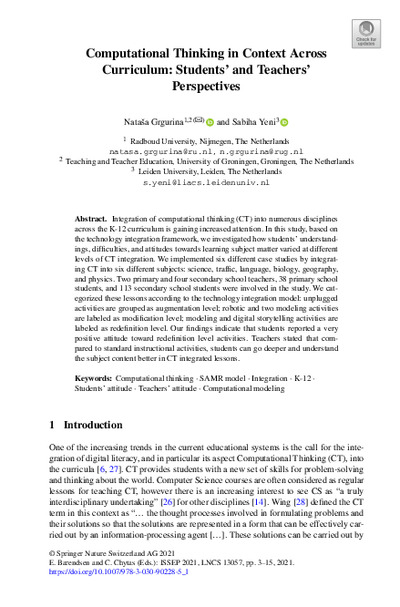Computational Thinking in Context Across CurriculumStudents’ and Teachers’ Perspectives
Natasa Grgurina, Sabiha Yeni
|
 |
 Diese Seite wurde seit 3 Jahren inhaltlich nicht mehr aktualisiert.
Unter Umständen ist sie nicht mehr aktuell.
Diese Seite wurde seit 3 Jahren inhaltlich nicht mehr aktualisiert.
Unter Umständen ist sie nicht mehr aktuell.
 Zusammenfassungen
Zusammenfassungen
 Integration of computational thinking (CT) into numerous disciplines across the K-12 curriculum is gaining increased attention. In this study, based on the technology integration framework, we investigated how students’ understandings, difficulties, and attitudes towards learning subject matter varied at different levels of CT integration. We implemented six different case studies by integrating CT into six different subjects: science, traffic, language, biology, geography, and physics. Two primary and four secondary school teachers, 38 primary school students, and 113 secondary school students were involved in the study. We categorized these lessons according to the technology integration model: unplugged activities are grouped as augmentation level; robotic and two modeling activities are labeled as modification level; modeling and digital storytelling activities are labeled as redefinition level. Our findings indicate that students reported a very positive attitude toward redefinition level activities. Teachers stated that compared to standard instructional activities, students can go deeper and understand the subject content better in CT integrated lessons.
Integration of computational thinking (CT) into numerous disciplines across the K-12 curriculum is gaining increased attention. In this study, based on the technology integration framework, we investigated how students’ understandings, difficulties, and attitudes towards learning subject matter varied at different levels of CT integration. We implemented six different case studies by integrating CT into six different subjects: science, traffic, language, biology, geography, and physics. Two primary and four secondary school teachers, 38 primary school students, and 113 secondary school students were involved in the study. We categorized these lessons according to the technology integration model: unplugged activities are grouped as augmentation level; robotic and two modeling activities are labeled as modification level; modeling and digital storytelling activities are labeled as redefinition level. Our findings indicate that students reported a very positive attitude toward redefinition level activities. Teachers stated that compared to standard instructional activities, students can go deeper and understand the subject content better in CT integrated lessons. Dieser wissenschaftliche Zeitschriftenartikel erwähnt ...
Dieser wissenschaftliche Zeitschriftenartikel erwähnt ...
 Dieser wissenschaftliche Zeitschriftenartikel erwähnt vermutlich nicht ...
Dieser wissenschaftliche Zeitschriftenartikel erwähnt vermutlich nicht ... 
 Nicht erwähnte Begriffe | Kinder, LehrerIn, Lehrplan 21, Unterricht |
 Tagcloud
Tagcloud
 Anderswo finden
Anderswo finden
 Volltext dieses Dokuments
Volltext dieses Dokuments
 |  Computational Thinking in Context Across Curriculum: Students’ and Teachers’ Perspectives: Artikel als Volltext @ Springer ( Computational Thinking in Context Across Curriculum: Students’ and Teachers’ Perspectives: Artikel als Volltext @ Springer ( : :  , 219 kByte; , 219 kByte;  : :  ) ) |
 Anderswo suchen
Anderswo suchen 
 Beat und dieser wissenschaftliche Zeitschriftenartikel
Beat und dieser wissenschaftliche Zeitschriftenartikel
Beat hat Dieser wissenschaftliche Zeitschriftenartikel während seiner Zeit am Institut für Medien und Schule (IMS) ins Biblionetz aufgenommen. Er hat Dieser wissenschaftliche Zeitschriftenartikel einmalig erfasst und bisher nicht mehr bearbeitet. Beat besitzt kein physisches, aber ein digitales Exemplar. Eine digitale Version ist auf dem Internet verfügbar (s.o.). Es gibt bisher nur wenige Objekte im Biblionetz, die dieses Werk zitieren.









 computer science unplugged
computer science unplugged Primarschule (1-6) / Grundschule (1-4)
Primarschule (1-6) / Grundschule (1-4) Programmieren
Programmieren Roboter
Roboter SAMR-Model
SAMR-Model Schule
Schule
 Biblionetz-History
Biblionetz-History